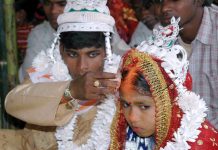This article is written by Shubhangi Agrawal, currently pursuing B.A.LLB (Hons.) from Hidayatullah National Law University, Raipur (C.G.). This article gives a brief idea about child marriage law and its applicability irrespective of religion with the help of the mentioned case.
Table of Contents
Introduction
Child marriage was banned in India long ago in 1929 as a result of the Child Marriage Restraint Act. But still, child marriage is a valid marriage in the eyes of law. How? Now that’s a point of discussion. The legal age of marriage for girls is 18 years and for boys, it’s 21 years. But certainly, if a person by their own will or consent of the guardian marries, their marriage will be considered valid until declared otherwise by the minor party.
Child marriage is a violation of human rights. Girls may be more prone to such marriages but it is certainly an issue for both the sexes of the society. Child marriages constitute almost 27% of the total marriages in India which has seen a reduction of 5%. If the division of child marriage is seen among both the sexes, one of the three child brides from all over the world is in India. In India there are 223 million child brides and, one in 25 men is married before the age of 18 years but this isn’t the legal age of marriage for men, further, the statistics show one in 5 men is married before the legal age i.e. 21 years.
Child Marriage: Widespread evil
Child marriage does not only have illegal aspects but surely is harmful to individuals and society. Child marriage is surely devastating and has to be ended for which International efforts have also been taken with the insertion of child marriage as a Sustainable Development Goal (SDG) which is the elimination of child marriage by 2030. It is not an evil restricted to a religion or a society; it affects the whole set of human beings. Child marriage surely has negative implications on adolescents and children trapped in this, it surely restricts their health and growth as an individual. Often children are made to marry in unions and live as married people even before they can realize the responsibility that marriage brings along. The girls are made to do tons of household work which has worse effects on their health and development. We can surely see a decrease in the urban areas but rural areas still need attention and lots of implementation of the law to curb this menace. Many international countries have come together to adhere to this SDG and control child marriage in their respective countries.
India ranks among the 4th position in the 8 (eight) South Asian countries which prohibit and restrict children’s development. Seeing the current scenario and the proportions of children getting married before the legal age, it can surely be curbed in India for the male gender with efforts diverted towards the same. But to achieve no child marriage in the case of females is a task with such high numbers, but no efforts get wasted. Policies need to be implemented and religious support is also the need of the hour as they should encourage people to abide by the law of the land to get success in the implementation of the same. The most important thing is proper enforcement of the laws.
Child marriage law: The universal law in India
The Child Marriage Restraint Act,1929 was the first law brought up in Indian society to curbing the exorbitant amount of damages that were caused due to child marriage that didn’t perform well and caused disappointment in the masses. The major failures of the law were that its section focused on restraining the solemnization of marriage instead of prohibiting the people from performing it, police requiring orders from the magistrate to arrest the guilty person. Lesser reports being registered as the act itself had restrictions on complaining after 1 year of marriage. The Act also didn’t impose any strict actions on the people not following or adhering to it. Simple imprisonment for a maximum period of 3 months is not enough to vanish this evil which has been prevailing present in society for centuries, it surely requires stricter actions and punishments.
After the loopholes present in this law and no exceptional results shown by the act. In addition, it was also causing an increase in cases of child marriage. Seeing all this the parliament came up with the present applicable law i.e the Prohibition of Child Marriage Act, 2006. This act applies to all religions and the entire population of the country, as well as the personal laws that apply to each religious group or community. This law provides grounds and a basis for the protection of children from child marriage.
The core aspects of the law are:
- The legal age of marriage has been kept the same as was described under the previous law which is 18 years for girls and 21 years for boys.
- A separate section is framed under the Act to include special officers in the police who would be working on the ground as full-time “child marriage prohibition officers” in every state. The important work of these officers would be of course preventing child marriage but also arresting the guilty people who may be parents of such children and even performing rescue tasks for children in dangerous situations.
- As stated in the very beginning, child marriage has to be declared void, it is made voidable by the Act on the part of the party who is minor at the time of marriage. Thus the declaration of voidability needs to be done anytime up to two years of attaining adulthood.
- The exception to the above situation where marriage can be declared void is in the situation of kidnapping, coercion, misrepresentation, fraud, or deceit.
- The Act clearly and explicitly prohibits any arrangement or performance or participation in child marriage.
- The Act puts a penalty on the respondent party which may only be excused if the respondent successfully proves that it had a reason to believe that the other party was not a child.
- The Act also puts an obligation on the child’s guardian or parents to prevent any such negligent Act on the part of the child and in failing to do so, they may face the consequences mentioned in the Act.
Certainly, the law is focused mainly on the protection of children but this also puts a burden on children to exercise the relief available. The Act allows children to only approach the court in their capacity. There might be high chances that children do not have the right knowledge or even resources for such an approach. There are very few cases under the Act where people have approached the court solely on the ground of age and received relief. As the minor need to approach on their own but legally they require someone who can represent them and expecting their parents or guardians to help them is just a naive thing as we all are aware that there are very high chances that the arrangement of child marriage is finalized by the parents/guardians themselves on the child owing to the societal pressure and the orthodox nature of the families so of course there would zero support from their side. Without family support, the child who has gotten into this arrangement is very prone to be in the situation where they might not have resources as well as the courage to approach the court, and also a child to having a “next best friend” who is major and in addition to that willing to take stand for the minor person and help them in the presence of from the family is a very unlike situation to arrive at. Seeing all these practical downfalls the Act may be said to lack the proper framing required for effective implementation.
The other inconsistency that the Act has is in terms of the personal laws as people for the matter of marriage are generally governed under their laws and the Act is not consistent with several of them. This might lead to serious legal complications. But there are certainly cases where the Prohibition of Child Marriage Act, 2006 (PCMA) has been given an independent stance and has proved beneficial for the parties irrespective of the religious laws which are enforced on the parties.
An insight into the case of Jaspreet Kaur & Anr. v. State of Punjab & Ors
In this case, the petitioner wanted to seek the protection of life and liberty under Article 21 of the Constitution which is also a fundamental right granted by the Constitution to the people. The facts of the case were that petitioner was married to a Muslim boy when she was just aged 18 years whereas the boy was below the legal age of marriage as per PCMA, 2006 but being Muslim personal law applied to the boy this was the bowl of contention. The case started by stating that none of the parties were in a prohibited relationship or were married before the marriage in question.
The contention of the parties to the case
The petitioner was seeking protection based on the fundamental right to life and liberty after marrying the Muslim boy against the will of the family. The petitioner was also contending that since it is the fundamental right granted to every citizen it should be granted immediately without further questioning on the said marriage of the couple with the instructions to the responsible authority to make sure no harm or threat is put on the petitioners by the mentioned respondents.
Findings of the court
In the above case, Justice Amol Ratan Singh found that petitioner no. 1 Jaspreet Kaur has attained the legal age of marriage as per the verification certificate produced in the court. Court also established that petitioner No. 2 Azim Khan has not attained the legal age of marriage according to PCMA,2006 but as known the legal age if seen with the perspective of the Muslim Personal Law which says that a person can legally marry after the attainment of puberty or 15 years of age whichever is earlier, in contrast to this here it was also made clear that the Protection of child marriage act, 2006 is a secular state of act and doesn’t differentiate based on religion. But as observed by the Hon’ble Supreme Court in the case of Hardev Singh v. Harpreet Kaur if the girl was above 18 years of age then no offense could be made out under the provisions of the Act. The protection was also granted based on the earlier judgement made in the case of Hardev Singh v. Harpreet Kaur.
Furthermore, it was also made clear by the court that if in the future the certified age or any other document produced in the court is forged then this order would not restrict the marriage to be adjudicated under the child marriage Act. This duly acknowledges the fact that in due course of times many instances have been visible where there is a dispute between the law of the land and the personal laws but of course personal laws are only applicable until they are inconsistent with the law of the land.
The said petition was disposed of by the court with an assured order in favor of the petitioner for the protection of life and liberty under all circumstances under the fundamental right of life and liberty.
Conclusion
Child marriage cannot be allowed in the aspects of religious or personal law. People have to be very particular about the law enforced upon us as an individual of the society, to maintain harmony and conscience. It is very important to keep the law of the land over and above the personal or religious laws, as people might seek personal laws as an easy path to escape from the said conditions and may take undue advantage of the same. The development of each child is important and the responsibility of the state is to provide equal protection and treatment to all, irrespective of the religion they belong to.
References
- http://www.legalserviceindia.com/legal/article-4818-child-marriage.html
- https://thewire.in/rights/child-marriage-laws-india
LawSikho has created a telegram group for exchanging legal knowledge, referrals and various opportunities. You can click on this link and join:
 Serato DJ Crack 2025Serato DJ PRO Crack
Serato DJ Crack 2025Serato DJ PRO Crack











 Allow notifications
Allow notifications



